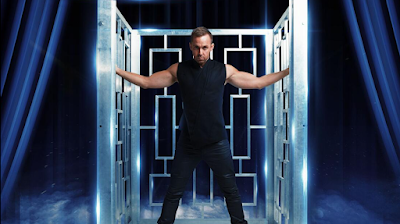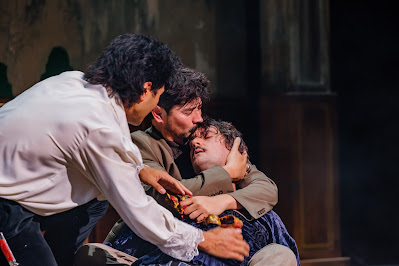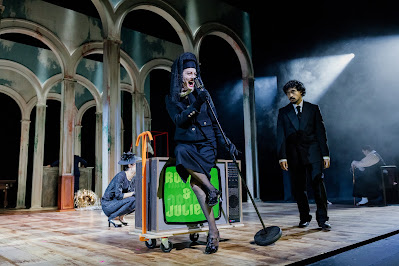Years into their relationship, Tim and Millie find themselves at a crossroads as they move to the country. With tensions already flaring, an encounter with an unnatural force threatens to corrupt their lives, their love and their flesh.
Michael Shanks’ new film Together offers a chilling yet surprisingly tender look at the gradual breakdown of a relationship. It blends psychological drama and body horror in a way that feels both uncomfortable and deeply recognisable. Anchored by real-life couple Dave Franco and Alison Brie, the film tells the story of two long-term partners navigating both emotional stagnation and supernatural consequences. On the surface, it’s about a couple whose bodies start to fuse together after a strange encounter in a rural cave. But underneath, it’s an exploration of what happens when two people stay together not out of love, but out of habit and dependency.
Tim and Millie have been together for around a decade. That sort of time brings with it history, shared memories, and deep emotional ties. But it also brings a slow evolution, sometimes in different directions. At the beginning of the film, they’re making a big life change, moving from the city to a small town so Millie can take up a teaching job. Millie is thoughtful and grounded, while Tim is a drifting musician still chasing a dream that never quite materialised. He doesn't drive, doesn’t have much of a plan, and relies heavily on Millie to get to and from his gigs. It's not just inconvenient; it's symbolic of the imbalance between them.
Millie, ever patient, is growing weary. It’s clear she cares for Tim, but her energy is running out. Their communication is brittle and half-hearted, and at times they appear more like cohabitants than romantic partners. This shift in tone is felt right from their awkward farewell party, where Millie proposes to Tim in front of their friends. He reacts poorly, frozen with discomfort, a moment that casts a long shadow over the rest of the film.
What follows is a slow, uncomfortable spiral into something far more disturbing. During a hike, Tim drinks from a strange pool of water in a dark cave. Rather than falling ill, he begins to experience horrifying changes. Without clear explanation, his body starts seeking union with Millie’s. Shanks avoids over-explaining the supernatural elements, leaving the audience to interpret the cave and its curse as metaphors rather than concrete threats. What’s more important is what these transformations reveal about the characters and their bond. The body horror is not just for spectacle. It visualises the creeping, unspoken co-dependence that has quietly taken root between them.
The physical merging of Tim and Millie is grotesque and intimate in equal measure. It reflects the way long-term relationships can blur personal boundaries. When two people are together for so long, it can become difficult to tell where one ends and the other begins. That blurring, in Together, becomes literal. The horror here is not just in the loss of bodily autonomy, but in the realisation that neither Tim nor Millie seems able to function without the other.
Shanks maintains a steady tone throughout the film, favouring slow-burn tension over big shocks. There are only a few moments of truly graphic horror, and many of the more disturbing transformations are kept just out of view. This may frustrate fans of high-intensity body horror, but it serves the story’s emotional core. What’s truly frightening isn’t the gore, but the quiet collapse of a once-loving relationship.
The performances carry much of the emotional weight. Brie captures Millie’s exhaustion and frustration with nuance, showing a woman trying to stay supportive even as she doubts her choices. Franco brings depth to Tim, whose flaws are evident but understandable. His lack of ambition and direction are not just personal failings but signs of unresolved grief and low self-worth. Together, they create a dynamic that feels both deeply familiar and increasingly unsettling. They don’t hate each other. In fact, there’s still affection there. But they’re clearly no longer in sync, and neither of them knows what to do about it.
The film draws attention to shifting gender roles in subtle ways. Millie is the provider, emotionally and financially, while Tim stays at home and drifts. Their conversations about intimacy and support reverse the expected norms. Millie asks for physical connection while Tim looks for emotional reassurance. These switches are not presented as flaws but as symptoms of a relationship that has been quietly breaking under pressure.
The horror elements, supported by a mix of practical and digital effects, are handled with surprising restraint given the subject matter. Credit goes to the effects team for creating believable moments of body transformation without overwhelming the emotional beats. The rural setting is used well, giving a sense of isolation that mirrors the characters’ emotional distance from their old lives; and from each other.
Where the film falters is in its final act. After spending most of its runtime establishing atmosphere and emotional depth, the film tries to deliver a more traditional conclusion. It attempts to explain the supernatural elements in a straightforward way, resolving questions that might have been better left ambiguous. The ending also leans into familiar genre tropes, which feels out of step with the more grounded, psychological tone of the earlier scenes. While it doesn’t ruin the film, it does soften its impact.
Still, Together remains a compelling entry into the body horror genre because it uses its supernatural premise to say something very real. It is about how relationships change over time, and how people often stay together not because of love, but because of fear; fear of change, fear of loneliness, or fear of failure. These are uncomfortable truths, and Shanks presents them with honesty and care.
The choice to focus on emotional horror over shock value makes the film feel more grounded, even when things get bizarre. It encourages viewers to reflect on their own relationships and how easy it is to become stuck in routines that no longer serve anyone. By the time the credits roll, the horror of the story is not just in the grotesque merging of flesh, but in the idea that love alone may not be enough to hold two people together.
Together is not a perfect film, but it is a thoughtful and quietly disturbing one. It speaks to anyone who has felt trapped in a relationship that once brought joy but now brings confusion. With strong performances and a clear thematic vision, it leaves a lasting impression; not because of what you see, but because of what you feel.











.jpg)
.jpg)
.jpg)
.jpg)





















